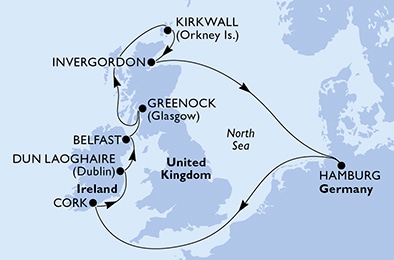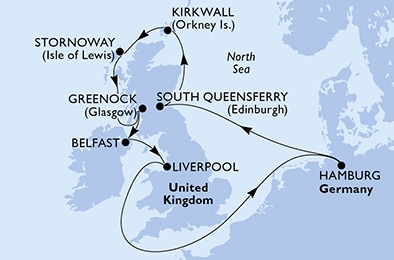
Port Greenock (Glasgow)
Greenock, a historic town located on the Clyde Coast in Scotland, lies just 25 miles west of Glasgow and offers a unique blend of maritime heritage, scenic beauty, and cultural ties to its larger neighbor. Once a thriving port during Scotland’s industrial heyday, Greenock retains much of its charm, with attractions like the Custom House, an impressive neoclassical building that reflects the town’s storied past as a hub of trade and shipbuilding. Visitors can also explore the McLean Museum and Art Gallery, which showcases local history, art, and exhibits related to Greenock’s seafaring legacy.
Set against the backdrop of the Firth of Clyde, Greenock is a gateway to stunning landscapes and outdoor activities. The Lyle Hill viewpoint offers breathtaking panoramas of the Clyde Estuary and the surrounding hills, while the town’s proximity to the Scottish Highlands and islands makes it an ideal starting point for exploring the region. Though smaller in scale, Greenock’s connection to Glasgow, Scotland’s largest city, provides easy access to its vibrant arts scene, historic landmarks, and world-class shopping, making Greenock a charming and convenient destination with a mix of small-town appeal and big-city connections.
History
Greenock, located on the southern bank of the River Clyde in Scotland, has a history closely tied to its role as a maritime and industrial hub. First established as a small fishing village, its origins can be traced back to the 12th century, though it remained relatively rural and undeveloped for several centuries. Greenock's fortunes changed dramatically in the 17th and 18th centuries, as it became a key port for Glasgow’s growing trade networks. The construction of the West Harbour in the early 1700s marked the beginning of its transformation into an important shipping and shipbuilding center. By the late 18th century, Greenock was heavily involved in transatlantic trade, including commerce with the Americas, and later played a significant role in Scotland’s industrial revolution.
In the 19th century, Greenock became synonymous with shipbuilding, establishing itself as one of the premier ship construction centers in the British Empire. The town also saw rapid growth in population and infrastructure during this period, with industries such as sugar refining and engineering flourishing alongside maritime trade. However, the 20th century brought challenges, as Greenock’s traditional industries declined after World War II. Despite this, the town's historical significance endures, with landmarks such as the Custom House and James Watt Memorial, honoring the famous inventor and engineer born in Greenock. Today, Greenock’s history reflects its rise as a critical port and industrial powerhouse that contributed greatly to Scotland’s economic development.





 With bus transport to the port
With bus transport to the port







